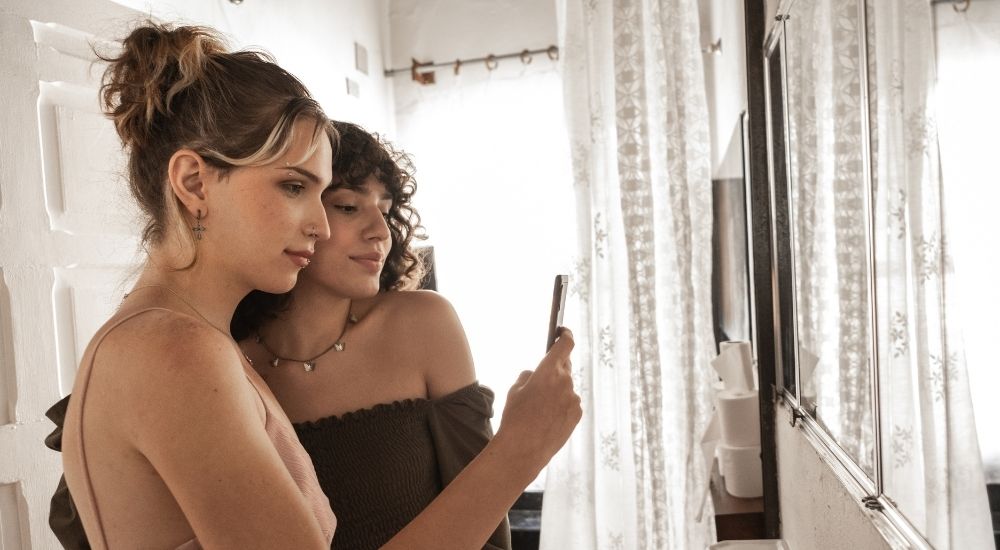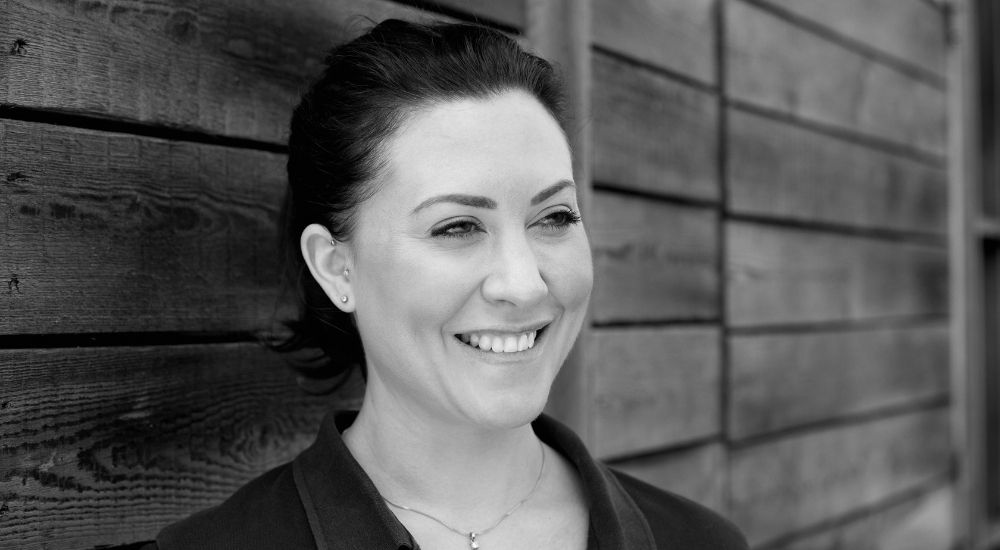As Australians celebrate Mardi Gras 2022, we spoke to Sam Marshall, the UK beauty therapist and educator, making the beauty industry a more inclusive space for trans clients and staff.
Sam Marshall started her beauty career with intimate waxing in 1998. She learnt the trade in Australia – but when she got home, she found it was something of a niche. “When I returned to the UK in the early 2000s, nobody was doing it here. It was considered a bit kinky, like ‘oooh, I’m getting an intimate wax!'”
Being ahead of the curve helped kick start Sam’s career as a therapist and educator. Clients travelled to her, and she eventually built a business educating other therapists. Now, of course, intimate waxing and hair removal are as ubiquitous and uncontroversial as getting a manicure.
Sam knows things change quickly in beauty, and she is accelerating change for one specific group: trans-identifying clients and staff.
Last year, Gallup released survey data indicating that one in six Gen Z adults in the US identifies as LGBT. Of this cohort, 11.3% identify as transgender. Younger people are more comfortable exploring gender and sexuality than previous generations (for example, less than 2% of Americans born before 1965 identify as LGBT). As reported by Bloomberg, this generation has money to burn (that’s $360 billion in USD of disposable income) – convincing them to spend is the trick. They are a values-driven cohort – they spend money on items and experiences that mirror their identity and values and their desire to make the world a better place. They now represent 40% of all consumers in the US, and businesses are just catching up.
Sam realised the beauty therapy industry had a problem with trans inclusiveness when she volunteered at the Manchester LGBT foundation. “As a beauty therapist, the obvious thing to do was offer free nails and free brow shaping. Loads of people I met there were trans.” Sam grew up in a small town in the UK, where there wasn’t much of a queer scene. She previously hadn’t considered that a space that has historically been welcoming for women and gay men was far from for trans people. “Then, during the lockdown in 2020, one of my close friends came out as a trans man. I think having that emotional connection made me realise, there needs to be more help.”
Sam now works with HABIA, the Hair and Beauty Industry Authority, and the British Beauty Industry Council’s inclusion committee. She has launched two virtual training programs delivered in-house in the UK for salons, spas and beauty therapists: Trans Awareness for Spas and Introduction to Trans Awareness for Hair, Nails and Beauty.
We talked to Sam about the beauty industry’s challenges in catering to this market and how beauty businesses can create welcoming spaces for everyone.

What are some of the problematic experiences trans people encounter in the beauty therapy space?
“If I use the example of a friend of mine’s example, he’s a trans man. Before he transitioned, he loved going to spas – he went to spas worldwide! But since his transition, he hasn’t. When you think of the process at a spa, you get undressed for a treatment. You get changed into swimmers for the pool, you get undressed again for the sauna. My friend wears a binder for his breasts, as he hasn’t had top surgery. He wears a rashie over this when he’s swimming. The binder is made of elastic fabric that becomes uncomfortable and hard to remove if you get it wet.”
“Then, for instance, if you’re a trans woman – you might be wearing a wig, you’re not going to take them off to go swimming if you haven’t had bottom reassignment surgery, you won’t want to throw on any old swimming costume, you might need to tuck. So there are a lot of factors that can create anxiety for a trans person.”
“Not to mention the reactions of other guests – staring or comments. For someone who is at the beginning of their journey, transitioning can be very uncomfortable, and that is why in the UK, we’re seeing that trans people are just not using these spaces.”
“In terms of massage services, we make a few recommendations. If someone is lying on their back, you can see the curve of the breast through their towel. For a trans man, that can be very uncomfortable as their breasts make them not feel like them!”
“So we’ll recommend perhaps a more extended massage laying on their front. You can also put towels down the side to avoid any accidental touching of the area.”
“For beauty salons, where there is less intense massage, it’s more about what not to ask and what not to say. Generally, it is with 40+ therapists as younger therapists are more likely to know somebody who is trans. There are certain things people say without meaning to offend, “Like oh my friend, she’s a real woman”, or asking questions about someone’s dead name (the name someone used before they transitioned) or “what did you look like when you were a girl” “oh you were so pretty as a girl!” The classic one is “Have you had the op?”
“I hear a lot from my clients that on their second visit with a beauty therapist, the beauty therapist thinks they can ask anything. On their second visit, I wouldn’t say to my client “what does your vagina look like?” So why would I ask this of a trans client? “
“My general rule is that if they don’t divulge, we will not talk about it.”
What about trans or gender-non-conforming employees in the beauty therapy industry?
“I have a client who works in Melbourne in a spa, and she goes to work as a man. Because if she went to work as a trans woman, she wouldn’t be hired. It’s crucial that when you’re recruiting, you’re not discriminating. I remember 20 years ago, writing grooming guidelines, and we would say “no visible tattoos or piercings.” But then everyone started getting tattoos and piercings, and we were like – okay, we need to relax that. Now it’s very unusual to not see a beauty therapist with a tattoo on her wrist.”
“As trans people are more comfortable coming out, this is the client, the potential staff member. The industry is catching up, and it is about whether you want to be an early adopter, creating an inclusive space, or do you want to be the last to welcome everyone and get trans and gender nonconforming clients? “
“In the course, we do provide support with how to speak to customers who might be like, “Oh that’s a man, he shouldn’t be here.” And how to politely say, “we’re an inclusive business, and we don’t accept any form of harassment.” In English law, transgender discrimination holds the same weight as racial discrimination under the Equality act, which is helpful.”
What can a business do tomorrow to create a more inclusive space for clients?
“Educating yourself is number one. If there isn’t a course like ours in Australia, they should be!”
“There’s no point introducing pronouns on a booking form if when that person comes in, they’re being asked silly questions, or the team has no idea what that means. It’s not just he her. They/them or they/she – as some people use two pronouns, it can confuse someone who doesn’t understand the trans umbrella. So educate yourself and your team about the trans umbrella, the gender identity spectrum, and the difference between gender, sex and sexual orientation before putting anything on your booking forms. Many people want to jump to the end, but you have to start at the beginning.”
“Then think about how you present your business on social media and in your advertising. Over here our spas and salons use pretty, white cis models in their advertising. Maybe the occasional token Asian or black model, but you never see trans people. Especially for spas, you never see curvy people. They try to find the prettiest person with perfect skin and plonk them in the advert!”
“Removing gender from services is also really important. Here we have men’s barbers and women’s hairdressers, and my partner Keri who has their program #hairhasnogender is trying to dismantle that. But it’s not necessary to have “men’s nails” or “ladies’ waxing” on a service menu, and if it’s not needed, get rid of it!”
“Some things that we say a lot are “you don’t need to understand it, but you do need to respect it” and also “human first.” Treat every client and staff member as a human first before treating them as male, female or non-binary.”
Have a question? You can reach out to Sam at sam@betransaware.co.uk
Follow Be Trans Aware’s new Instagram for updates.
Read the current issue of our digital magazine here:
- For more news and updates, subscribe to our weekly newsletter
- Follow us on Instagram
- Like us on Facebook
- Join Australia’s largest network of beauty industry professionals on LinkedIn
- Subscribe to our print magazine
Have an idea for a story or want to see a topic covered on our site and in our pages? Get in touch at info@professionalbeauty.com.au.

